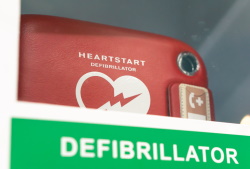Introduction
Emergencies can strike at any moment, and knowing how to respond successfully can save lives. Whether it's an office crash, a roadway accident, or an abrupt health situation, being outfitted with the right first aid skills is vital. The value of first aid can not be overemphasized; it acts as the initial line of protection against worsening problems while waiting on expert clinical help. In this extensive overview, we will certainly check out the different elements of offering first aid in emergencies making use of a detailed step-by-step technique.
What is Initial Aid?
First aid refers to the prompt aid supplied to someone suffering from an injury or ailment till specialist clinical assistance shows up. It incorporates a range of techniques and procedures that can support a person's condition and also avoid additional damage. Comprehending the basics of first aid is critical for both people and communities.
Understanding DRSABCD in First Aid
What Does DRSABCD Stand For?
- D - Risk: Ensure the setting is safe for you and the victim. R - Response: Check for responsiveness; drink the person delicately and ask if they are okay. S - Send out for Help: If unresponsive, call emergency situation solutions immediately. A - Air passage: Make certain the airway is clear by turning the head back and raising the chin. B - Breathing: Look for typical breathing; appearance, listen, and really feel for breath. C - CPR: If there's no breathing, commence CPR (Cardiopulmonary Resuscitation). D - Defibrillation: Make Use Of an AED (Automated External Defibrillator) if available.
Understanding DRSABCD is basic to efficient first aid. Each element plays an integral function in examining a scenario and determining the necessary actions.

How to Use DRSABCD?
In technique, using DRSABCD involves a collection of steps that one have to follow carefully:
Assessing Threat: Always prioritize your security prior to approaching a victim. Checking Reaction: Delicately drink or heckle the individual to inspect their alertness. Calling for Assistance: In situations where instant clinical assistance is needed, call emergency solutions without delay. Clearing Air passage: Usage methods like jaw drive or chin lift if needed. Checking Breathing: Observe breast movements or pay attention for breath sounds. Performing CPR: If unresponsive and not breathing typically, start CPR right away-- 30 compressions complied with by two rescue breaths. Using AED: If defibrillation equipment is readily available, follow its instructions promptly.These sequential actions permit you to offer systematic aid while waiting for specialist help.
Basic Life Support (BLS) Techniques
What Is Fundamental Life Support?
Basic Life Support (BLS) consists of life-saving techniques that any person can learn to help somebody experiencing heart attack or breathing failing until emergency situation solutions get here. BLS focuses mostly on maintaining flow and oxygenation with CPR.
Importance of Basic Life Support Training
Training in BLS prepares individuals for real-life emergency situations by instilling self-confidence in their ability to act decisively when every second counts.
Key Parts of BLS
Chest Compressions: Crucial for maintaining blood circulation throughout heart arrest. Rescue Breaths: Supply oxygen when breathing has stopped. Defibrillation: Using an AED efficiently boosts opportunities of survival post-cardiac arrest.Cardiopulmonary Resuscitation (CPR)
What Is CPR?
Cardiopulmonary Resuscitation (CPR) is a crucial lifesaving technique utilized in emergencies when a person's heart beat or breathing has stopped.
When Needs to You Execute CPR?
CPR ought to be administered right away if:

- An individual is unresponsive There are no indicators of breathing An observed collapse takes place
Steps to Carry out CPR
Call emergency solutions immediately before starting CPR. Place your hands on the center of the individual's chest. Push down hard and fast at least 2 inches deep at a rate of 100-- 120 compressions per minute. After every 30 compressions, offer 2 rescue breaths if trained.Knowing how to execute CPR can significantly increase survival prices after sudden cardiac events.
First Help Techniques for Common Injuries
Choking Incidents
Choking occurs when an object blocks air movement into the lungs. Identifying indications such as inability to talk or cough can lead you to act quickly.
Steps to Help Choking Victims
Ask them if they're choking; if of course:- Encourage them to cough if able. Administer back blows complied with by abdominal drives (Heimlich maneuver).
Cuts and Scrapes
Minor cuts need basic cleaning and wrapping while extreme cuts might require specialist clinical attention.
How to Deal with Cuts?
Rinse under clean water. Apply antibiotic lotion if available. Cover with sterilized bandage.Burns Treatment
Burns differ from minor scalds to extreme injuries requiring prompt treatment based on severity.

Treating Minor Burns:
Cool under running water for 20 minutes. Cover with clean and sterile dressing without sticking straight onto burn area.Mental Health and wellness First Aid
What Is Mental Health and wellness First Aid?
Mental health and wellness first aid describes sustain offered throughout mental health and wellness crises that are equally as crucial as physical injuries requiring immediate response.
Importance of Mental Health and wellness Awareness
Recognizing signs and symptoms like anxiety attack or serious stress and anxiety assists offer ideal assistance until expert help arrives.
FAQs About First Aid
1. The length of time does a first aid certificate last?
A normal first aid certificate lasts 3 years prior to needing renewal via refresher courses or re-training sessions.
2. Where can I discover a first aid training course near me?
You can search online utilizing search phrases such as "first aid course near me" or check out community centers offering regional training programs.
3. What are common signs indicating someone requires CPR?
Symptoms consist of unresponsiveness, absence of regular breathing, or absence of pulse upon inspecting carotid artery.
4. What's associated with taking a mental health and wellness first aid course?
Courses normally cover recognizing mental health problems, providing first support methods, recognizing situation situations, and understanding when to refer people for more help.
5. Are there on-line choices for first aid training?
Yes! On the internet platforms supply detailed courses allowing adaptability in learning about numerous aspects consisting of CPR accreditation local courses for cpr available from home.
6. Why ought to I take a hands-on handling training course?
Manual handling training lessens risks associated with injuries because of improper training techniques which generally take place in work environments across different industries.
Conclusion
Providing first aid in emergencies requires expertise, skillsets obtained with committed training programs like HLTAID011 Provide First Aid, effective interaction under pressure, and an understanding of human anatomy's standard principles such as those covered in standard life support best cpr certification courses near me training programs like CPR courses close-by you!
The details shared below intends not only at gearing up visitors with functional abilities however also fostering confidence that they can make substantial choices throughout situations-- saving lives one action each time! By participating in pertinent training programs such as psychological health and wellness first aid courses along with typical accreditations like getting your first aid certification through acknowledged bodies makes certain readiness across all fronts-- whether caring physically or emotionally!
Remember: equally counts! Taking those actions toward ending up being certified equips you-- and can suggest everything when confronted with unanticipated obstacles needing a prompt reaction! So why wait? Register today right into any type of nearby courses such as "firstaidpro" offerings tailored around boosting your capability today!
This short article gives you with in-depth understandings right into offering first aid during emergency situations adhering to best techniques while making sure quality through extensive headings/sub-headings together with actionable material-- equipping visitors in the direction of aggressive preparedness approaches making sure preparedness in the middle of unforeseen situations ahead!